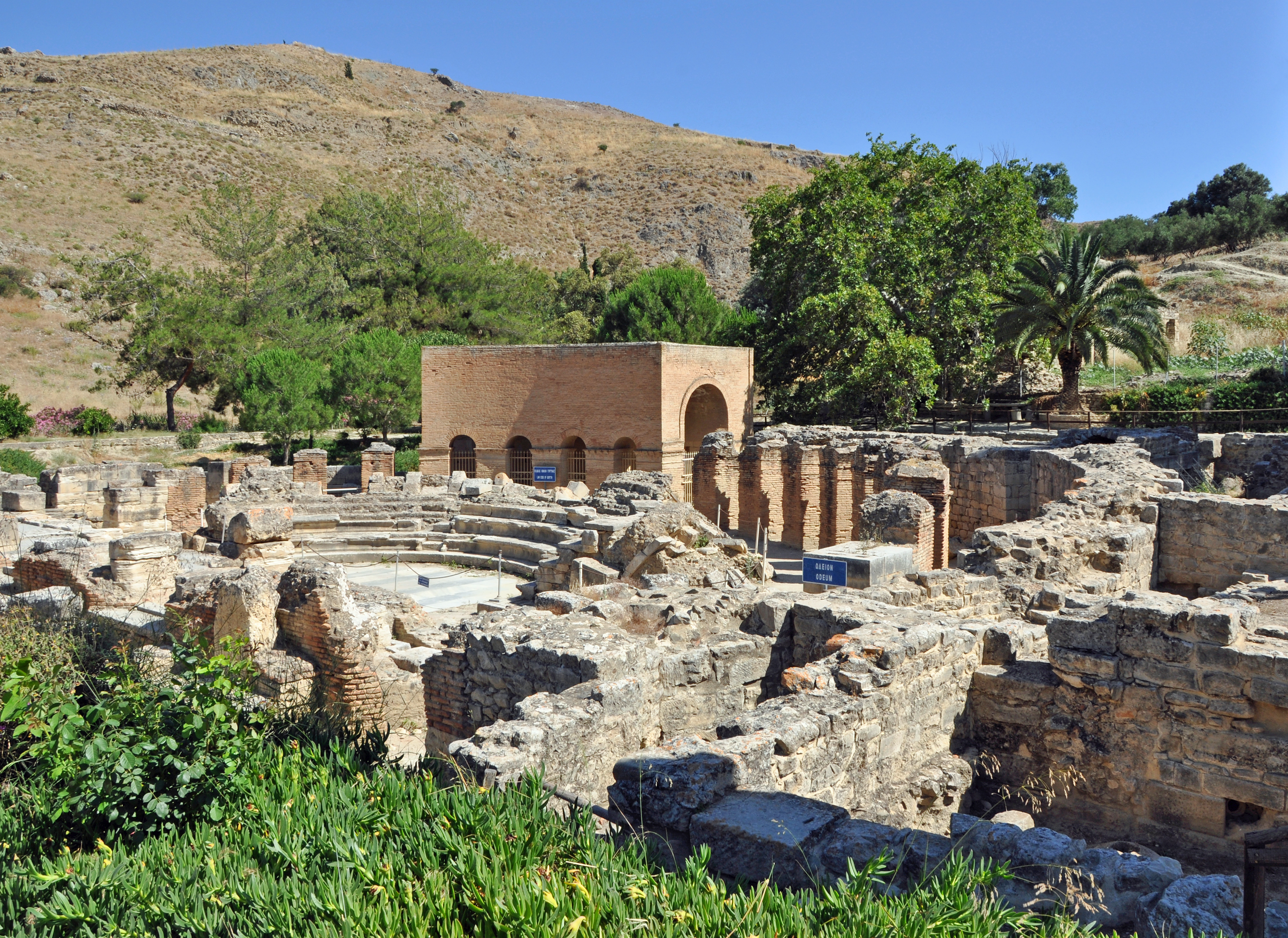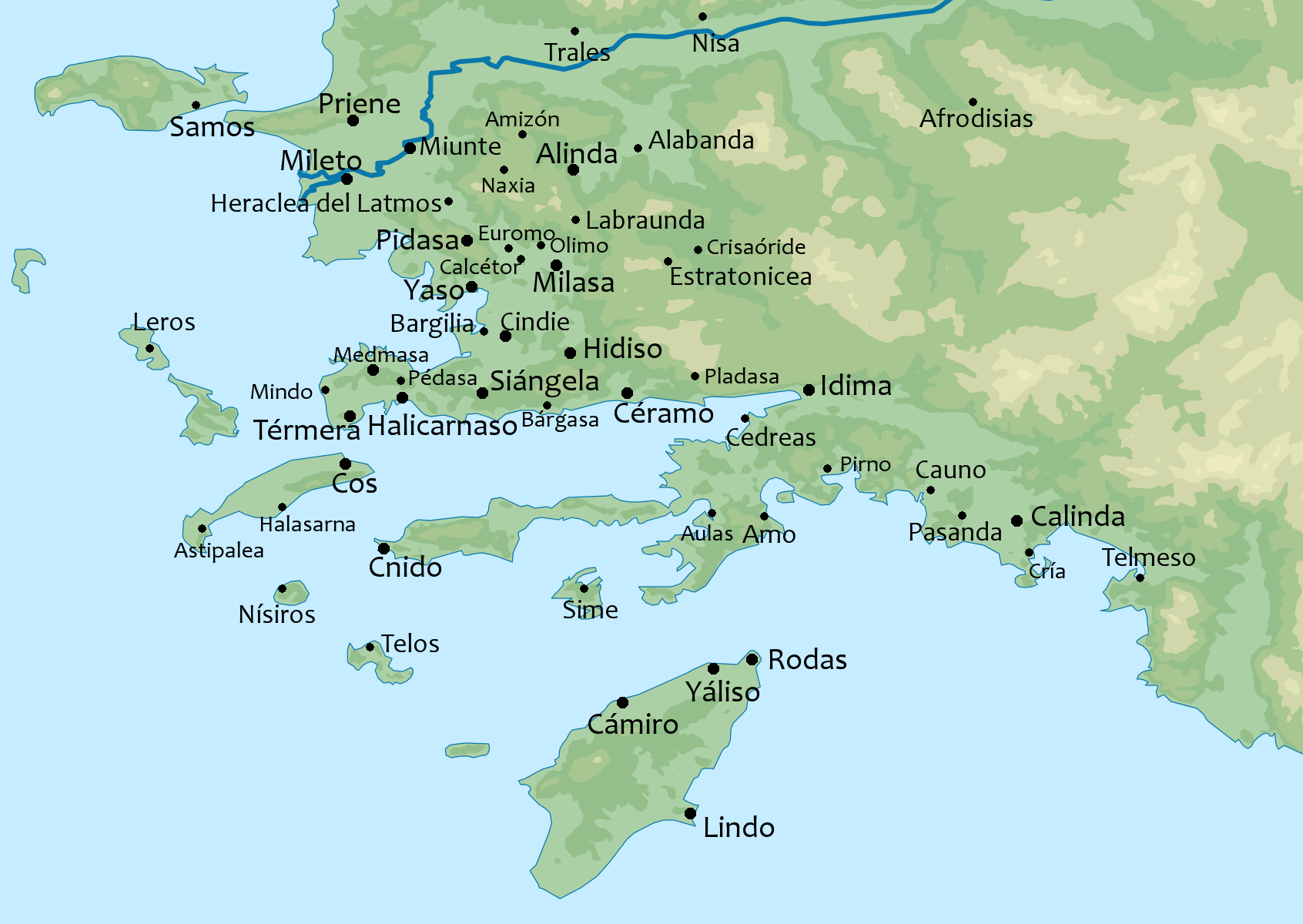|
Aulon (Crete)
Aulon ( grc, Ἀϝλόν), known later as Alonion (Άλονίων), was a town and '' poleis'' (city-state) of ancient Crete. It is mentioned in a decree of 480 BCE of Gortyna where a series of privileges are granted to a person perhaps of foreign origin among which were land and housing in Aulon. Of this decree it has been deduced that Aulon was a city that was fortified and was dependent on Gortyna but that probably had autonomy in some aspects. About this relationship between Aulon and Gortyna analogies have been noted with that between Halicarnassus and Salmacis. Its site is located near Agioi Deka Agioi Deka ( el, Άγιοι Δέκα, "Holy Ten") is a village in the Heraklion regional unit, Greece, with 861 inhabitants (2011 census). It is located in the 44th km of the Heraklion-Tympaki national road and it is the centre of the municipalit ... ('Ten Saints'), which refers to ten Christian martyrs killed at the amphitheatre of Alonion. References Populated pla ... [...More Info...] [...Related Items...] OR: [Wikipedia] [Google] [Baidu] |
Poleis
''Polis'' (, ; grc-gre, πόλις, ), plural ''poleis'' (, , ), literally means "city" in Greek. In Ancient Greece, it originally referred to an administrative and religious city center, as distinct from the rest of the city. Later, it also came to mean the body of citizens under a city's jurisdiction. In modern historiography, the term is normally used to refer to the ancient Greek city-states, such as Classical Athens and its contemporaries, and thus is often translated as "city-state". The ''poleis'' were not like other primordial ancient city-states like Tyre or Sidon, which were ruled by a king or a small oligarchy; rather, they were political entities ruled by their bodies of citizens. The Ancient Greek ''poleis'' developed during the Archaic period as the ancestor of the Ancient Greek city, state and citizenship and persisted (though with decreasing influence) well into Roman times, when the equivalent Latin word was ''civitas'', also meaning "citizenhood", whil ... [...More Info...] [...Related Items...] OR: [Wikipedia] [Google] [Baidu] |
Oxford University Press
Oxford University Press (OUP) is the university press of the University of Oxford. It is the largest university press in the world, and its printing history dates back to the 1480s. Having been officially granted the legal right to print books by decree in 1586, it is the second oldest university press after Cambridge University Press. It is a department of the University of Oxford and is governed by a group of 15 academics known as the Delegates of the Press, who are appointed by the vice-chancellor of the University of Oxford. The Delegates of the Press are led by the Secretary to the Delegates, who serves as OUP's chief executive and as its major representative on other university bodies. Oxford University Press has had a similar governance structure since the 17th century. The press is located on Walton Street, Oxford, opposite Somerville College, in the inner suburb of Jericho. For the last 500 years, OUP has primarily focused on the publication of pedagogical texts a ... [...More Info...] [...Related Items...] OR: [Wikipedia] [Google] [Baidu] |
Ancient Crete
The history of Crete goes back to the 7th millennium BC, preceding the ancient Minoan civilization by more than four millennia. The palace-based Minoan civilization was the first civilization in Europe. After the Minoan civilization was devastated by the Thera eruption, Crete developed an Ancient Greece-influenced organization of city-states, then successively became part of the Roman Empire, the Byzantine Empire, the Venetian Republic, the Ottoman Empire, an autonomous state, and the modern state of Greece. Prehistoric Crete In 2002, the paleontologist Gerard Gierlinski discovered what he claimed were fossil footprints left by ancient human relatives 5,600,000 years ago, but the claim is controversial. Excavations in South Crete in 2008–2009 revealed stone tools at least 130,000 years old. This was a sensational discovery, as the previously accepted earliest sea crossing in the Mediterranean was thought to occur around 12,000 BC. The stone tools found in the ''Pla ... [...More Info...] [...Related Items...] OR: [Wikipedia] [Google] [Baidu] |
Gortyna
Gortyna ( grc, Γόρτυνα; also known as Gortyn (Γορτύν)) was a town of ancient Crete which appears in the Homeric poems under the form of Γορτύν; but afterwards became usually Gortyna (Γόρτυνα). According to Stephanus of Byzantium it was originally called Larissa (Λάρισσα) and Cremnia or Kremnia (Κρήμνια). History This important city was next to Cnossus in importance and splendour; in early times these two great towns had entered into a league which enabled them to reduce the whole of Crete under their power; in after-times when dissensions arose among them they were engaged in continual hostilities. It was originally of very considerable size, since Strabo reckons its circuit at 50 stadia; but when he wrote it was very much diminished. He adds that Ptolemy Philopator had begun to enclose it with fresh walls; but the work was not carried on for more than 8 stadia. In the Peloponnesian War, Gortyna seems to have had relations with Athens. ... [...More Info...] [...Related Items...] OR: [Wikipedia] [Google] [Baidu] |
Halicarnassus
Halicarnassus (; grc, Ἁλικαρνᾱσσός ''Halikarnāssós'' or ''Alikarnāssós''; tr, Halikarnas; Carian: 𐊠𐊣𐊫𐊰 𐊴𐊠𐊥𐊵𐊫𐊰 ''alos k̂arnos'') was an ancient Greek city in Caria, in Anatolia. It was located in southwest Caria, on an advantageous site on the Gulf of Gökova, which is now in Bodrum, Turkey.} The city was famous for the Mausoleum of Halicarnassus, also known simply as the Tomb of Mausolus, whose name provided the origin of the word "mausoleum". The mausoleum, built from 353 to 350 BC, ranked as one of the seven wonders of the ancient world. Halicarnassus' history was special on two interlinked issues. Halicarnassus retained a monarchical system of government at a time when most other Greek city states had long since rid themselves of their kings. And secondly, while their Ionian neighbours rebelled against Persian rule, Halicarnassus remained loyal to the Persians and formed part of the Persian Empire until Alexander the ... [...More Info...] [...Related Items...] OR: [Wikipedia] [Google] [Baidu] |
Salmacis (Caria)
Salmacis or Salmakis ( grc, Σαλμακίς) was a town of ancient Caria. While the famed fountain appears in Strabo, the town is only mentioned in inscriptions. It was a ''polis'' (city-state) and a member of the Delian League The Delian League, founded in 478 BC, was an association of Greek city-states, numbering between 150 and 330, under the leadership of Athens, whose purpose was to continue fighting the Persian Empire after the Greek victory in the Battle of Pl .... Its site is unlocated. References Populated places in ancient Caria Former populated places in Turkey Greek city-states Members of the Delian League Lost ancient cities and towns {{AncientCaria-geo-stub ... [...More Info...] [...Related Items...] OR: [Wikipedia] [Google] [Baidu] |
Agioi Deka
Agioi Deka ( el, Άγιοι Δέκα, "Holy Ten") is a village in the Heraklion regional unit, Greece, with 861 inhabitants (2011 census). It is located in the 44th km of the Heraklion-Tympaki national road and it is the centre of the municipality of Gortyna (Δήμος Γόρτυνας). The village is built on the feet of a green hill with view to the plain of Messara, at altitude of 170 meters, over the remains of ancient Gortys. It is supposed that the cemetery of Gortys was located in this area, and many of the old houses are built using recycled material from the ruins of Gortys. There is a local archaeological museum containing finds from the area. Other archaeological remains include the ''Praetorium'' located between Agioi Deka and Gortys, the tombs of Agioi Deka and the old church in the centre of the old village. Name The name of the village means Ten Saints, referring to the ten Martyrs of Crete (Agathopus, Basilides, Gelasius, Evaristus, Eunician, Euporus, Zoticus, T ... [...More Info...] [...Related Items...] OR: [Wikipedia] [Google] [Baidu] |
Populated Places In Ancient Crete
Population typically refers to the number of people in a single area, whether it be a city or town, region, country, continent, or the world. Governments typically quantify the size of the resident population within their jurisdiction using a census, a process of collecting, analysing, compiling, and publishing data regarding a population. Perspectives of various disciplines Social sciences In sociology and population geography, population refers to a group of human beings with some predefined criterion in common, such as location, race, ethnicity, nationality, or religion. Demography is a social science which entails the statistical study of populations. Ecology In ecology, a population is a group of organisms of the same species who inhabit the same particular geographical area and are capable of interbreeding. The area of a sexual population is the area where inter-breeding is possible between any pair within the area and more probable than cross-breeding with ... [...More Info...] [...Related Items...] OR: [Wikipedia] [Google] [Baidu] |
Former Populated Places In Greece
A former is an object, such as a template, gauge or cutting die, which is used to form something such as a boat's hull. Typically, a former gives shape to a structure that may have complex curvature. A former may become an integral part of the finished structure, as in an aircraft fuselage, or it may be removable, being using in the construction process and then discarded or re-used. Aircraft formers Formers are used in the construction of aircraft fuselage, of which a typical fuselage has a series from the nose to the empennage, typically perpendicular to the longitudinal axis of the aircraft. The primary purpose of formers is to establish the shape of the fuselage and reduce the column length of stringers to prevent instability. Formers are typically attached to longerons, which support the skin of the aircraft. The "former-and-longeron" technique (also called stations and stringers) was adopted from boat construction, and was typical of light aircraft built until ... [...More Info...] [...Related Items...] OR: [Wikipedia] [Google] [Baidu] |

.jpg)




